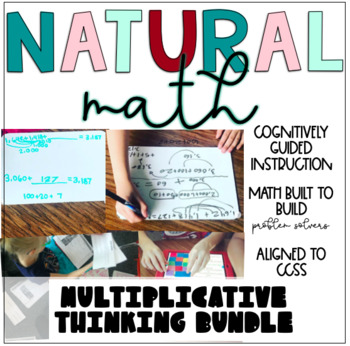Multiplication BUNDLE: Multiplicative Thinking Lessons-Conceptual Understanding
- Zip
What educators are saying
Products in this Bundle (7)
showing 1-5 of 7 products
Description
This is the COMPLETE bundle for a multiplicative thinking unit with conceptual understanding and cognitively guided instruction.
This bundle includes all 18 lessons with review pages, problem solving slides, number sense warm-up, and content slides.
The bundle also includes the multiplication focus wall, COMPLETE 3rd grade word wall, COMPLETE number sense activity resource, multiplication fact practice printables, and a small group station activity (grouping problems vs. additive problems sort)
EVERYTHING you need to dive deeply into multiplication and reasoning with a 3rd grade math classroom.
Natural Math is --> lessons that rely upon students' natural curiosity, intuition, and ability to solve. The teacher can help students turn that natural thinking into mathematical content.
Every lesson has 4 KEY COMPONENTS:
1. Review Pages: Once students have obtained a concept, retrieval practice is vital to insure that they are continually accessing that neural pathway. Every lesson has a spiral review "quiz".
2. Number Sense Warm-up: Every math lesson should have an overall number sense component, helping students build their intrinsic number line and think flexibly with numbers. ALL 13 of my math warm-ups are in the multiplicative reasoning unit (and can be bought separately here)
3. High-Cogntive Demand Problem Solving Task: This is one problem that is high-demand and open with multiple entry and exit points. Students will be working with a lot of math content as well as using mathematical practices. Solving these problems is a great way to introduce content, discuss it, and learn it deeply.
4. Content Slides: These are slides that include vocabulary, discussion, problem practice, graphic organizers, and more. Each lesson covers a different skill and is made for the teacher to use openly to meet the needs of their students.
Please email aubreeteaches@gmail.com with any questions or comments.
Visit the blog for MORE information on cognitively-guided math or problem solving!
Happy Teaching!


